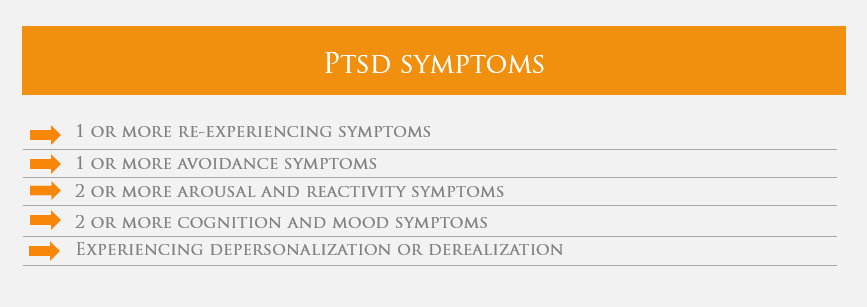
Post-Traumatic Stress Disorder, also known as PTSD, is a common mental disorder following exposure to immense stress or trauma. While once associated almost entirely with veterans following a war, an estimated 7-8 of all Americans will suffer from PTSD at some point during their lives. 80% of all people will experience a traumatic event at some point, and 20% of these go on to experience PTSD. Most importantly, PTSD often isn’t immediately noticeable, as some individuals may not experience real symptoms of PTSD for months after the event. PTSD is incredibly common, and about 8 million Americans qualify for diagnosis at any given time. If you or a loved one has been diagnosed with PTSD or has gone through a traumatic experience and are experiencing symptoms, it’s important to get treatment. Left untreated, Post-Traumatic Stress Disorder often just gets worse, causes complications, and reduces quality of life.
Most importantly, it’s treatable using medication, behavioral therapy, and counseling, and most people can quickly return to a healthy state of mind.
Symptoms of Post-Traumatic Stress Disorder
Post-Traumatic Stress Disorder symptoms are categorized into short-term and long-term or chronic symptoms. Most people who develop PTSD experience short-term symptoms. Only a small percentage go on to experience Chronic PTSD. In most cases, symptoms will begin within 3 months of the traumatic event.
PTSD Symptoms are defined in categories including “Re-experiencing”, “Avoidance”, “Arousal and Reactivity”, and Cognition and Mood”.
Diagnosing Post Traumatic Stress Disorder
It’s normal to experience some symptoms as listed above for at least a few weeks after a traumatic event. Persons with PTSD will experience them persistently, for the long term, and to a level that severely impacts their ability to function. PTSD is also often accompanied by anxiety and depression, substance abuse, and other disorders.
The DSM-5 stipulates that an individual must experience all of the following symptoms for at least one month.

PTSD can only be diagnosed by a medical doctor with experience with mental illnesses, such as a psychiatrist or psychologist.
Treatment for Post-Traumatic Stress Disorder
 PTSD is treated using a combination of medication and therapy. In most cases, post-traumatic stress disorder treatment heavily depends on the individual, their state of mind, the trauma, and whether or not it is ongoing. For example, an individual who has experienced a car accident and is now suffering from PTSD will likely be recommended to psychotherapy first. An individual who is suffering from PTSD following long-term exposure to spousal abuse must be treated holistically, removing the cause of the trauma before treating the trauma itself.
PTSD is treated using a combination of medication and therapy. In most cases, post-traumatic stress disorder treatment heavily depends on the individual, their state of mind, the trauma, and whether or not it is ongoing. For example, an individual who has experienced a car accident and is now suffering from PTSD will likely be recommended to psychotherapy first. An individual who is suffering from PTSD following long-term exposure to spousal abuse must be treated holistically, removing the cause of the trauma before treating the trauma itself.
Medication for PTSD
Medication was once the first and primary treatment for PTSD. Today, that’s no longer the case. However, many people with PTSD will still receive medications, such as short-term benzodiazepines, to remove the immediacy of anxiety caused by PTSD. Other medications frequently used to treat PTSD include antidepressants such as Selective-Serotonin Reuptake Inhibitors (SSRIs), sleep medications, and muscle relaxers. However, these medications are only intended to treat the temporary symptoms of PTSD while patients undergo primary treatment, or psychotherapy.
Psychotherapy for PTSD
Psychotherapy, including cognitive behavioral therapy (CBT) are the primary treatment for PTSD, typically delivered through either a hospital, an inpatient residential treatment center, or an outpatient treatment center. Here, individuals undergo programs ranging from 40-90 days or more, with therapies focused on improving behavior, reducing avoidance, and resolving trauma. Most post-traumatic stress disorder treatment programs will also include specific treatments to help individuals manage relationships, stress, social life, job, and family life, with changes dependent on the individual and their life.
Nearly all PTSD is based on either cognitive behavioral therapy or one of its derivatives, which may include DBT, EMDR, motivational therapy, acceptance therapy, etc. Two factors that are almost always included in PTSD treatment include:
 Exposure Therapy – Exposure therapy gradually exposes individuals to the trauma using writing, imagination, or visits to places where events happened, followed by sessions to help the individual resolve emotions. Exposure therapy heavily integrates tools to manage and understand emotions, to manage stress, and to develop life skills that will reduce stress.
Exposure Therapy – Exposure therapy gradually exposes individuals to the trauma using writing, imagination, or visits to places where events happened, followed by sessions to help the individual resolve emotions. Exposure therapy heavily integrates tools to manage and understand emotions, to manage stress, and to develop life skills that will reduce stress.
 Cognitive Restructuring – Cognitive restructuring is designed to help people make sense of memories, emotions, and experience. This therapy approaches these feelings from a scientific perspective, helping patients to understand what’s really going on, why, and what they can do about it.
Cognitive Restructuring – Cognitive restructuring is designed to help people make sense of memories, emotions, and experience. This therapy approaches these feelings from a scientific perspective, helping patients to understand what’s really going on, why, and what they can do about it.
In most cases, treatment centers will also offer complementary therapies to help reduce stress, improve emotional management and regulation, and to build healthy coping mechanisms.
PTSD Treatment Centers
Most individuals can seek out treatment from a variety of sources including psychiatrists, treatment centers, and counselors. Treatment centers deliver full-length PTSD treatment programs in inpatient or residential and outpatient settings.
If you or a loved one is struggling with PTSD, it’s important to get help. In some cases, PTSD will simply resolve on its own after 6-12 months. In others, it will continue to worsen, resulting in complications such as depression, anxiety, suicidal ideation, and panic attacks. PTSD significantly impacts quality of life, may impair an individual’s ability to function in normal social, work, or family settings. Treatment is accessible and it will help you or your loved one to get their life back.